Stock Market Analysis and Performance
VerifiedAdded on 2020/05/28
|18
|3396
|64
AI Summary
This assignment involves analyzing a set of historical stock market data spanning from January 2016 to December 2017. The dataset includes monthly closing prices, percentage changes (returns) between months, and calculated statistics such as the average return for 2017, annualized return, standard deviation, minimum, and maximum price observed over the five-year period. Students are expected to interpret this data to understand market trends and performance during the specified timeframe.
Contribute Materials
Your contribution can guide someone’s learning journey. Share your
documents today.
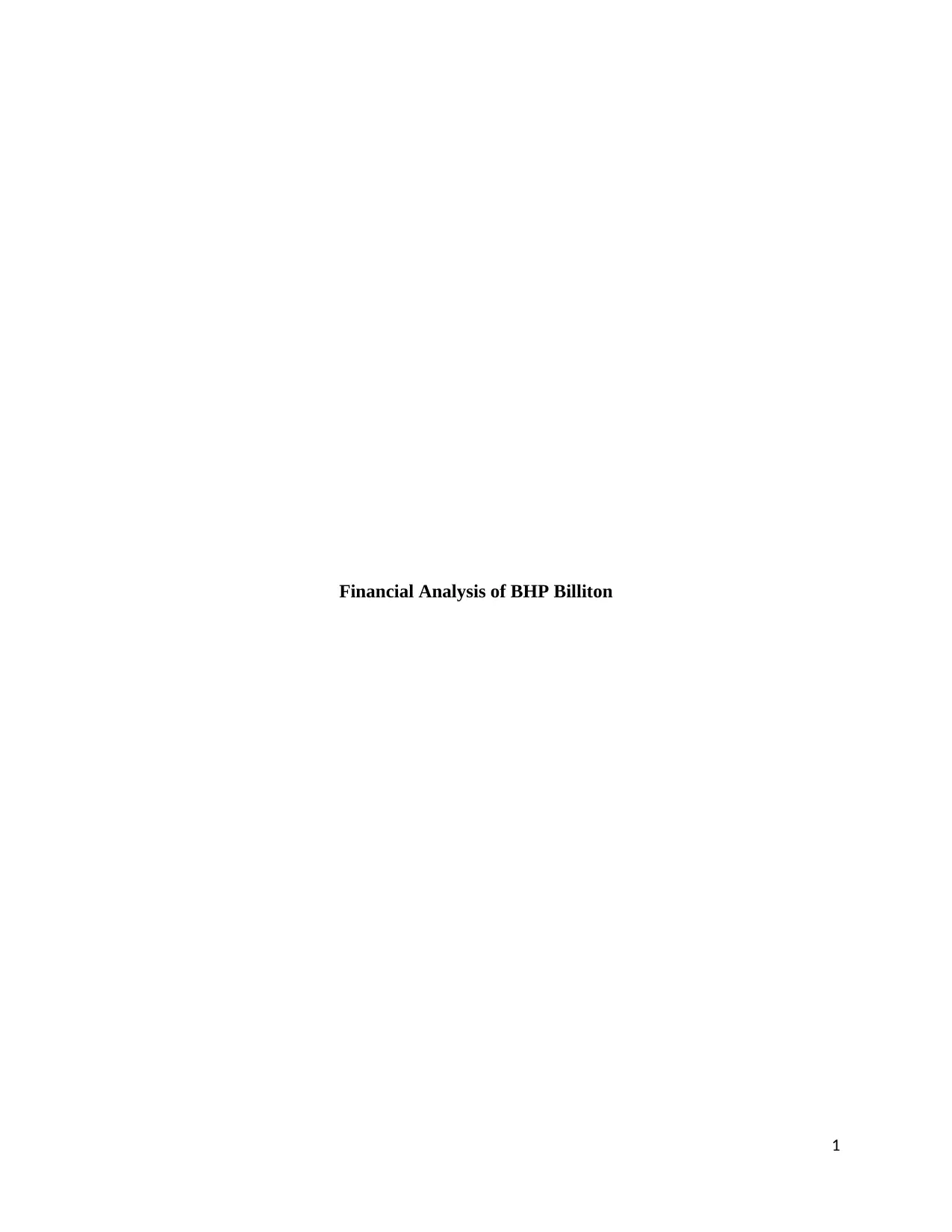
Financial Analysis of BHP Billiton
1
1
Secure Best Marks with AI Grader
Need help grading? Try our AI Grader for instant feedback on your assignments.

Description of Company: BHP Billiton Limited
BHP Billiton is a multinational company operating in many countries across the globe.
The company started operations in the year 1851 and since then it has grown manifold expanding
the business to various countries outside its origin country, Australia (BHP Billiton, 2018). The
company is head quartered in Melbourne, Australia but since it has business in the USA and the
UK also so it has subsidiaries spread in these countries. The company’s stock is listed and trades,
apart from on the Australian Stock Exchange (ASX), on London Stock Exchange (LSE) and
New York Stock Exchange (NYSE) also. The lead business of the company is to explore and
distribute the natural resources which it operates through four segments such as petroleum, coal,
copper, and iron ore (BHP Billiton, 2018). Here, a report has been prepared to analyze the
financial performance of BHP Billiton Limited and recommend the investors for investment in
the company.
Discussion of Form and Content of Annual Report
The annual report is an essential document that each and every listed company in
Australia has to submit to ASX annually (Dagwell, Wines, and Lambert, 2015). The annual
report of BHP Billiton Limited for the year 2017 has been submitted to ASX and it is available
on its website for public use. Anybody who wants can retrieve soft copy of the annual report of
the company from the bhp.com investor relations section. The annual report of BHP Billiton is
quite vast containing total 292 pages due to vide spread business (BHP Billiton, 2018).
Mainly, the annual report of BHP Billiton is divided into seven major sections. The first
major section contains strategic report, which initiates with chairman’s message and goes
through discussion on company’s strategies, vision, and its sustainability. Further, the strategic
2
BHP Billiton is a multinational company operating in many countries across the globe.
The company started operations in the year 1851 and since then it has grown manifold expanding
the business to various countries outside its origin country, Australia (BHP Billiton, 2018). The
company is head quartered in Melbourne, Australia but since it has business in the USA and the
UK also so it has subsidiaries spread in these countries. The company’s stock is listed and trades,
apart from on the Australian Stock Exchange (ASX), on London Stock Exchange (LSE) and
New York Stock Exchange (NYSE) also. The lead business of the company is to explore and
distribute the natural resources which it operates through four segments such as petroleum, coal,
copper, and iron ore (BHP Billiton, 2018). Here, a report has been prepared to analyze the
financial performance of BHP Billiton Limited and recommend the investors for investment in
the company.
Discussion of Form and Content of Annual Report
The annual report is an essential document that each and every listed company in
Australia has to submit to ASX annually (Dagwell, Wines, and Lambert, 2015). The annual
report of BHP Billiton Limited for the year 2017 has been submitted to ASX and it is available
on its website for public use. Anybody who wants can retrieve soft copy of the annual report of
the company from the bhp.com investor relations section. The annual report of BHP Billiton is
quite vast containing total 292 pages due to vide spread business (BHP Billiton, 2018).
Mainly, the annual report of BHP Billiton is divided into seven major sections. The first
major section contains strategic report, which initiates with chairman’s message and goes
through discussion on company’s strategies, vision, and its sustainability. Further, the strategic
2
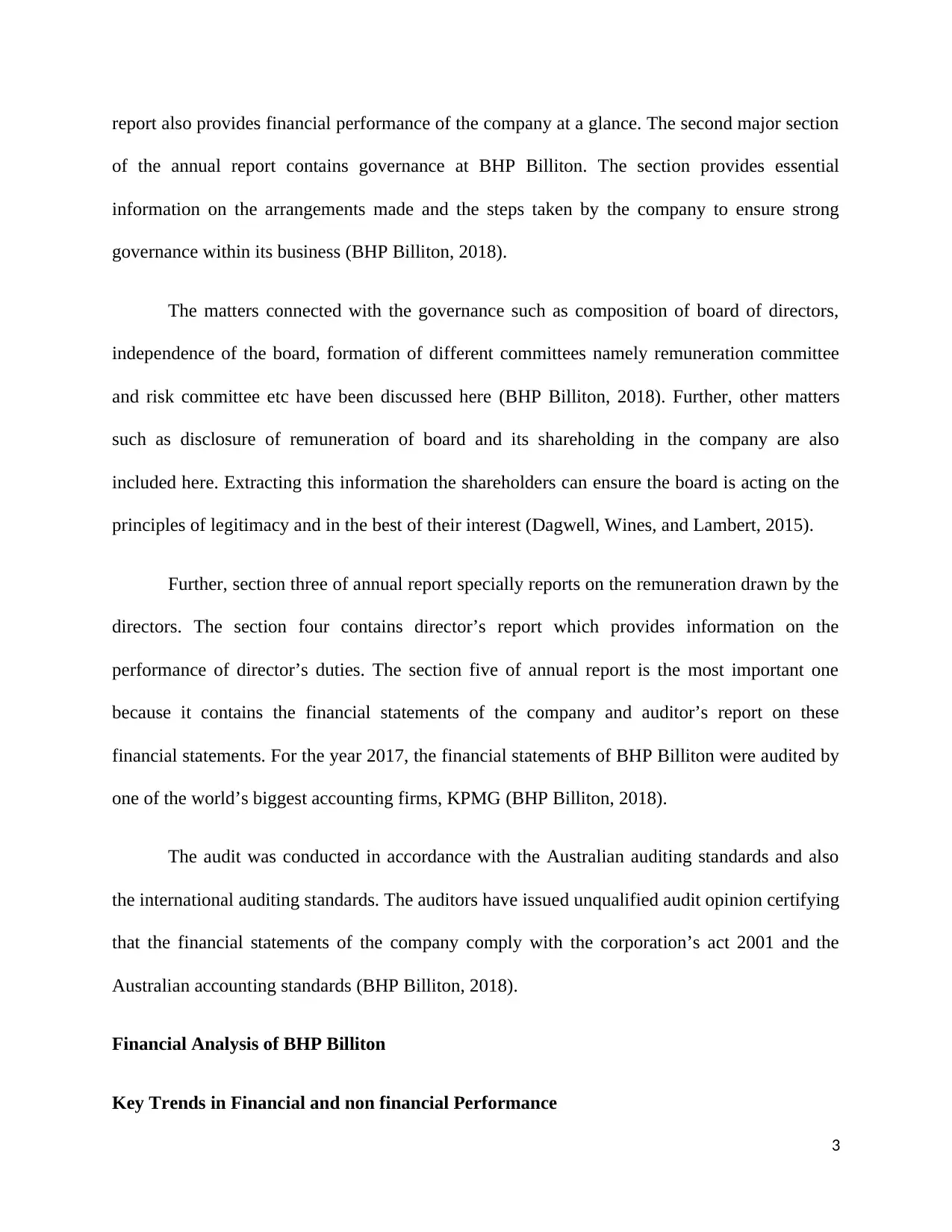
report also provides financial performance of the company at a glance. The second major section
of the annual report contains governance at BHP Billiton. The section provides essential
information on the arrangements made and the steps taken by the company to ensure strong
governance within its business (BHP Billiton, 2018).
The matters connected with the governance such as composition of board of directors,
independence of the board, formation of different committees namely remuneration committee
and risk committee etc have been discussed here (BHP Billiton, 2018). Further, other matters
such as disclosure of remuneration of board and its shareholding in the company are also
included here. Extracting this information the shareholders can ensure the board is acting on the
principles of legitimacy and in the best of their interest (Dagwell, Wines, and Lambert, 2015).
Further, section three of annual report specially reports on the remuneration drawn by the
directors. The section four contains director’s report which provides information on the
performance of director’s duties. The section five of annual report is the most important one
because it contains the financial statements of the company and auditor’s report on these
financial statements. For the year 2017, the financial statements of BHP Billiton were audited by
one of the world’s biggest accounting firms, KPMG (BHP Billiton, 2018).
The audit was conducted in accordance with the Australian auditing standards and also
the international auditing standards. The auditors have issued unqualified audit opinion certifying
that the financial statements of the company comply with the corporation’s act 2001 and the
Australian accounting standards (BHP Billiton, 2018).
Financial Analysis of BHP Billiton
Key Trends in Financial and non financial Performance
3
of the annual report contains governance at BHP Billiton. The section provides essential
information on the arrangements made and the steps taken by the company to ensure strong
governance within its business (BHP Billiton, 2018).
The matters connected with the governance such as composition of board of directors,
independence of the board, formation of different committees namely remuneration committee
and risk committee etc have been discussed here (BHP Billiton, 2018). Further, other matters
such as disclosure of remuneration of board and its shareholding in the company are also
included here. Extracting this information the shareholders can ensure the board is acting on the
principles of legitimacy and in the best of their interest (Dagwell, Wines, and Lambert, 2015).
Further, section three of annual report specially reports on the remuneration drawn by the
directors. The section four contains director’s report which provides information on the
performance of director’s duties. The section five of annual report is the most important one
because it contains the financial statements of the company and auditor’s report on these
financial statements. For the year 2017, the financial statements of BHP Billiton were audited by
one of the world’s biggest accounting firms, KPMG (BHP Billiton, 2018).
The audit was conducted in accordance with the Australian auditing standards and also
the international auditing standards. The auditors have issued unqualified audit opinion certifying
that the financial statements of the company comply with the corporation’s act 2001 and the
Australian accounting standards (BHP Billiton, 2018).
Financial Analysis of BHP Billiton
Key Trends in Financial and non financial Performance
3
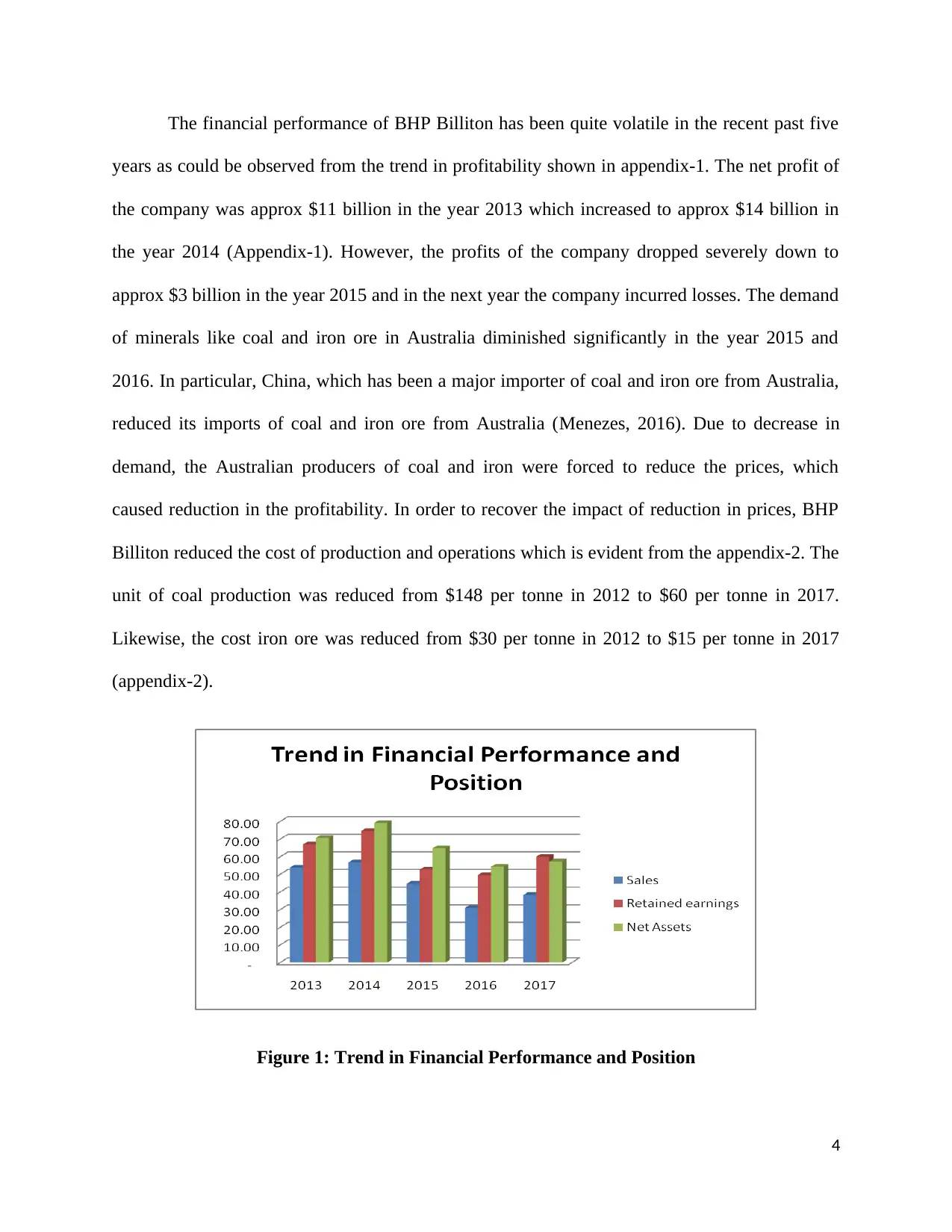
The financial performance of BHP Billiton has been quite volatile in the recent past five
years as could be observed from the trend in profitability shown in appendix-1. The net profit of
the company was approx $11 billion in the year 2013 which increased to approx $14 billion in
the year 2014 (Appendix-1). However, the profits of the company dropped severely down to
approx $3 billion in the year 2015 and in the next year the company incurred losses. The demand
of minerals like coal and iron ore in Australia diminished significantly in the year 2015 and
2016. In particular, China, which has been a major importer of coal and iron ore from Australia,
reduced its imports of coal and iron ore from Australia (Menezes, 2016). Due to decrease in
demand, the Australian producers of coal and iron were forced to reduce the prices, which
caused reduction in the profitability. In order to recover the impact of reduction in prices, BHP
Billiton reduced the cost of production and operations which is evident from the appendix-2. The
unit of coal production was reduced from $148 per tonne in 2012 to $60 per tonne in 2017.
Likewise, the cost iron ore was reduced from $30 per tonne in 2012 to $15 per tonne in 2017
(appendix-2).
Figure 1: Trend in Financial Performance and Position
4
years as could be observed from the trend in profitability shown in appendix-1. The net profit of
the company was approx $11 billion in the year 2013 which increased to approx $14 billion in
the year 2014 (Appendix-1). However, the profits of the company dropped severely down to
approx $3 billion in the year 2015 and in the next year the company incurred losses. The demand
of minerals like coal and iron ore in Australia diminished significantly in the year 2015 and
2016. In particular, China, which has been a major importer of coal and iron ore from Australia,
reduced its imports of coal and iron ore from Australia (Menezes, 2016). Due to decrease in
demand, the Australian producers of coal and iron were forced to reduce the prices, which
caused reduction in the profitability. In order to recover the impact of reduction in prices, BHP
Billiton reduced the cost of production and operations which is evident from the appendix-2. The
unit of coal production was reduced from $148 per tonne in 2012 to $60 per tonne in 2017.
Likewise, the cost iron ore was reduced from $30 per tonne in 2012 to $15 per tonne in 2017
(appendix-2).
Figure 1: Trend in Financial Performance and Position
4
Secure Best Marks with AI Grader
Need help grading? Try our AI Grader for instant feedback on your assignments.
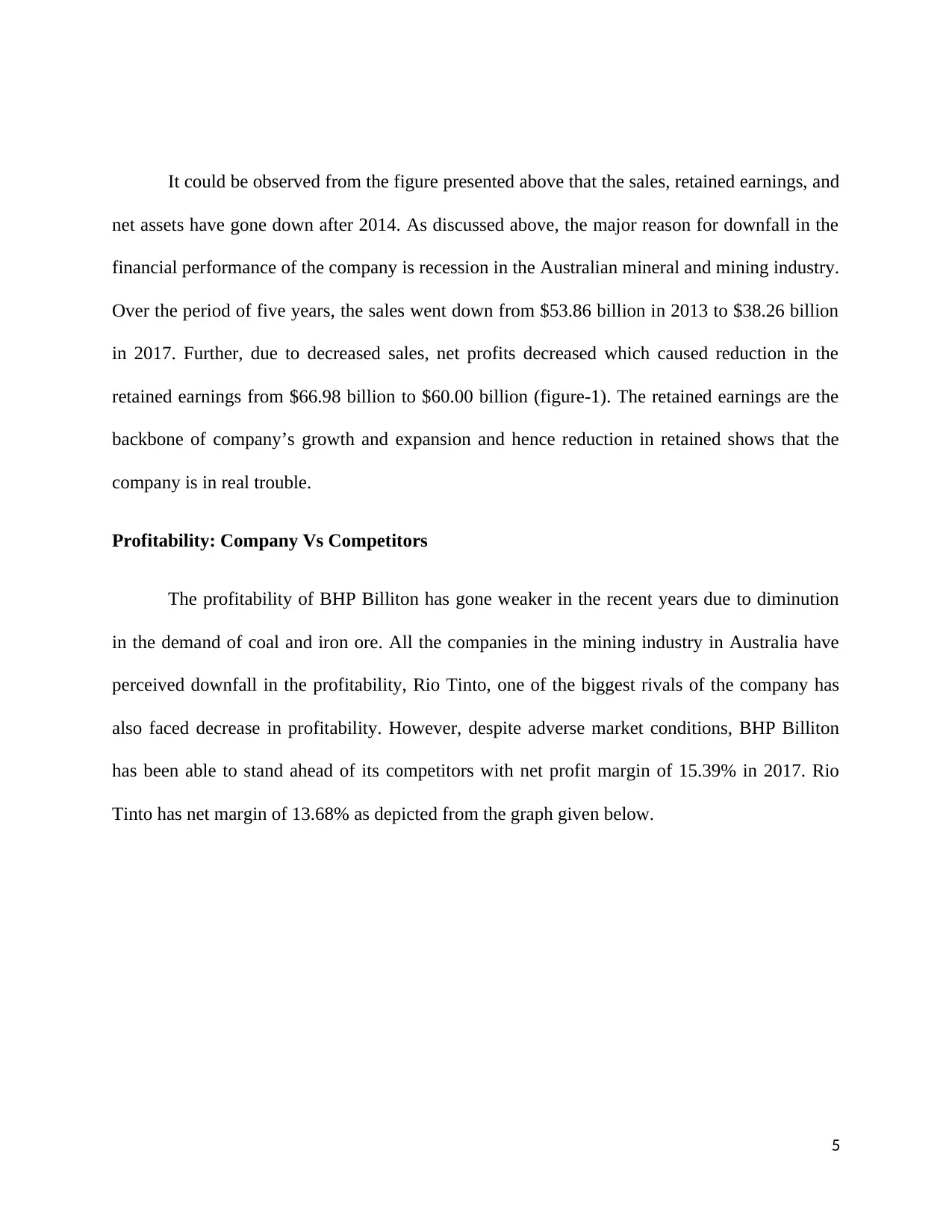
It could be observed from the figure presented above that the sales, retained earnings, and
net assets have gone down after 2014. As discussed above, the major reason for downfall in the
financial performance of the company is recession in the Australian mineral and mining industry.
Over the period of five years, the sales went down from $53.86 billion in 2013 to $38.26 billion
in 2017. Further, due to decreased sales, net profits decreased which caused reduction in the
retained earnings from $66.98 billion to $60.00 billion (figure-1). The retained earnings are the
backbone of company’s growth and expansion and hence reduction in retained shows that the
company is in real trouble.
Profitability: Company Vs Competitors
The profitability of BHP Billiton has gone weaker in the recent years due to diminution
in the demand of coal and iron ore. All the companies in the mining industry in Australia have
perceived downfall in the profitability, Rio Tinto, one of the biggest rivals of the company has
also faced decrease in profitability. However, despite adverse market conditions, BHP Billiton
has been able to stand ahead of its competitors with net profit margin of 15.39% in 2017. Rio
Tinto has net margin of 13.68% as depicted from the graph given below.
5
net assets have gone down after 2014. As discussed above, the major reason for downfall in the
financial performance of the company is recession in the Australian mineral and mining industry.
Over the period of five years, the sales went down from $53.86 billion in 2013 to $38.26 billion
in 2017. Further, due to decreased sales, net profits decreased which caused reduction in the
retained earnings from $66.98 billion to $60.00 billion (figure-1). The retained earnings are the
backbone of company’s growth and expansion and hence reduction in retained shows that the
company is in real trouble.
Profitability: Company Vs Competitors
The profitability of BHP Billiton has gone weaker in the recent years due to diminution
in the demand of coal and iron ore. All the companies in the mining industry in Australia have
perceived downfall in the profitability, Rio Tinto, one of the biggest rivals of the company has
also faced decrease in profitability. However, despite adverse market conditions, BHP Billiton
has been able to stand ahead of its competitors with net profit margin of 15.39% in 2017. Rio
Tinto has net margin of 13.68% as depicted from the graph given below.
5
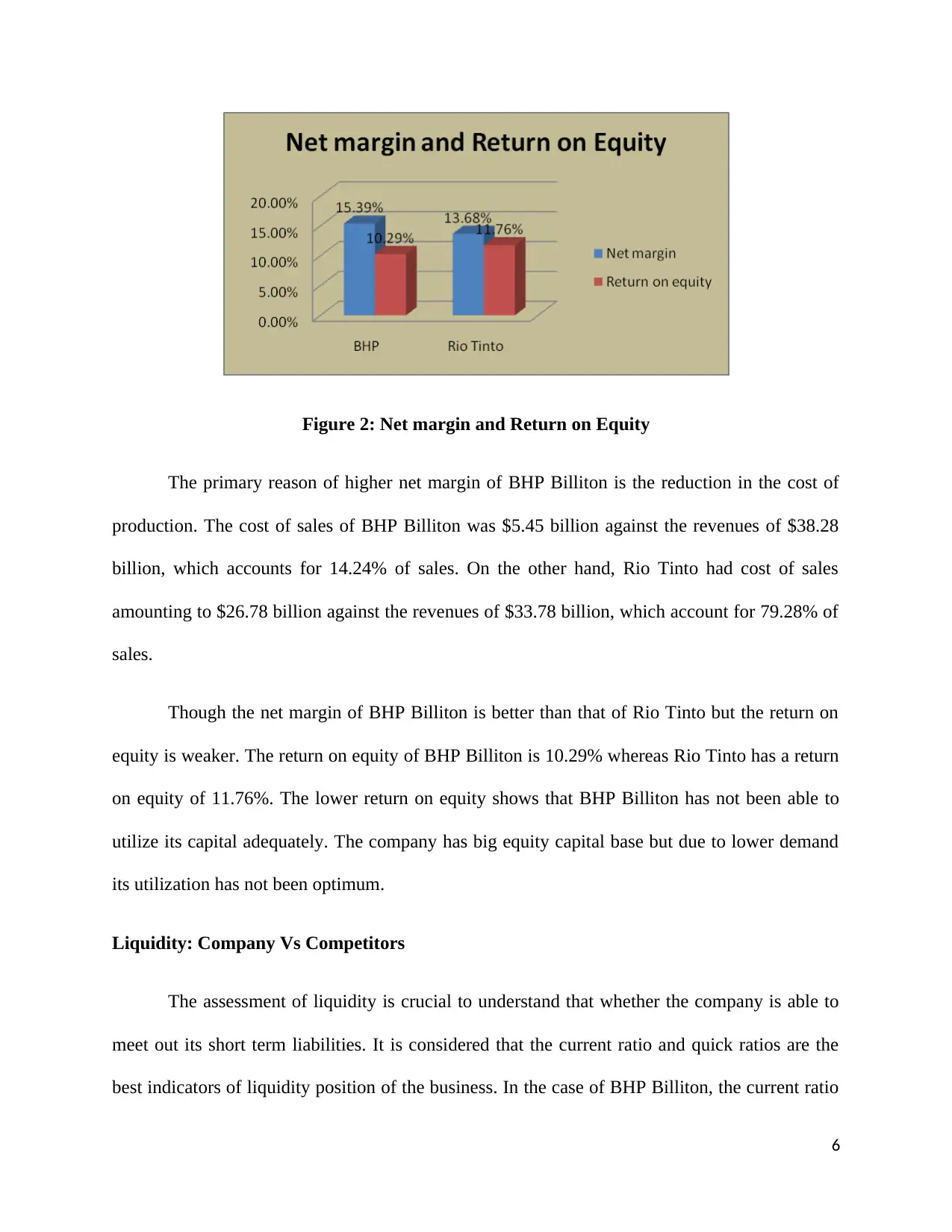
Figure 2: Net margin and Return on Equity
The primary reason of higher net margin of BHP Billiton is the reduction in the cost of
production. The cost of sales of BHP Billiton was $5.45 billion against the revenues of $38.28
billion, which accounts for 14.24% of sales. On the other hand, Rio Tinto had cost of sales
amounting to $26.78 billion against the revenues of $33.78 billion, which account for 79.28% of
sales.
Though the net margin of BHP Billiton is better than that of Rio Tinto but the return on
equity is weaker. The return on equity of BHP Billiton is 10.29% whereas Rio Tinto has a return
on equity of 11.76%. The lower return on equity shows that BHP Billiton has not been able to
utilize its capital adequately. The company has big equity capital base but due to lower demand
its utilization has not been optimum.
Liquidity: Company Vs Competitors
The assessment of liquidity is crucial to understand that whether the company is able to
meet out its short term liabilities. It is considered that the current ratio and quick ratios are the
best indicators of liquidity position of the business. In the case of BHP Billiton, the current ratio
6
The primary reason of higher net margin of BHP Billiton is the reduction in the cost of
production. The cost of sales of BHP Billiton was $5.45 billion against the revenues of $38.28
billion, which accounts for 14.24% of sales. On the other hand, Rio Tinto had cost of sales
amounting to $26.78 billion against the revenues of $33.78 billion, which account for 79.28% of
sales.
Though the net margin of BHP Billiton is better than that of Rio Tinto but the return on
equity is weaker. The return on equity of BHP Billiton is 10.29% whereas Rio Tinto has a return
on equity of 11.76%. The lower return on equity shows that BHP Billiton has not been able to
utilize its capital adequately. The company has big equity capital base but due to lower demand
its utilization has not been optimum.
Liquidity: Company Vs Competitors
The assessment of liquidity is crucial to understand that whether the company is able to
meet out its short term liabilities. It is considered that the current ratio and quick ratios are the
best indicators of liquidity position of the business. In the case of BHP Billiton, the current ratio
6
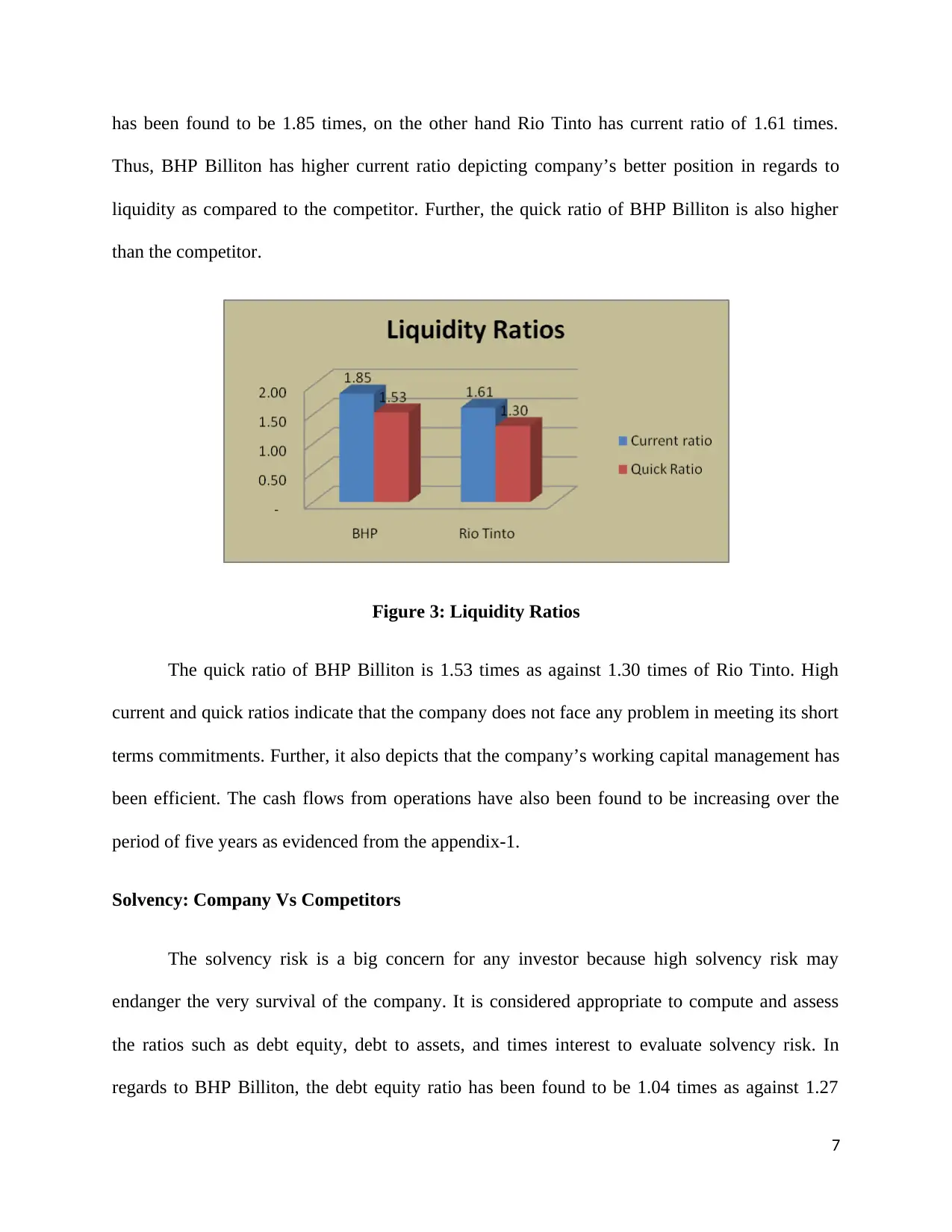
has been found to be 1.85 times, on the other hand Rio Tinto has current ratio of 1.61 times.
Thus, BHP Billiton has higher current ratio depicting company’s better position in regards to
liquidity as compared to the competitor. Further, the quick ratio of BHP Billiton is also higher
than the competitor.
Figure 3: Liquidity Ratios
The quick ratio of BHP Billiton is 1.53 times as against 1.30 times of Rio Tinto. High
current and quick ratios indicate that the company does not face any problem in meeting its short
terms commitments. Further, it also depicts that the company’s working capital management has
been efficient. The cash flows from operations have also been found to be increasing over the
period of five years as evidenced from the appendix-1.
Solvency: Company Vs Competitors
The solvency risk is a big concern for any investor because high solvency risk may
endanger the very survival of the company. It is considered appropriate to compute and assess
the ratios such as debt equity, debt to assets, and times interest to evaluate solvency risk. In
regards to BHP Billiton, the debt equity ratio has been found to be 1.04 times as against 1.27
7
Thus, BHP Billiton has higher current ratio depicting company’s better position in regards to
liquidity as compared to the competitor. Further, the quick ratio of BHP Billiton is also higher
than the competitor.
Figure 3: Liquidity Ratios
The quick ratio of BHP Billiton is 1.53 times as against 1.30 times of Rio Tinto. High
current and quick ratios indicate that the company does not face any problem in meeting its short
terms commitments. Further, it also depicts that the company’s working capital management has
been efficient. The cash flows from operations have also been found to be increasing over the
period of five years as evidenced from the appendix-1.
Solvency: Company Vs Competitors
The solvency risk is a big concern for any investor because high solvency risk may
endanger the very survival of the company. It is considered appropriate to compute and assess
the ratios such as debt equity, debt to assets, and times interest to evaluate solvency risk. In
regards to BHP Billiton, the debt equity ratio has been found to be 1.04 times as against 1.27
7
Paraphrase This Document
Need a fresh take? Get an instant paraphrase of this document with our AI Paraphraser
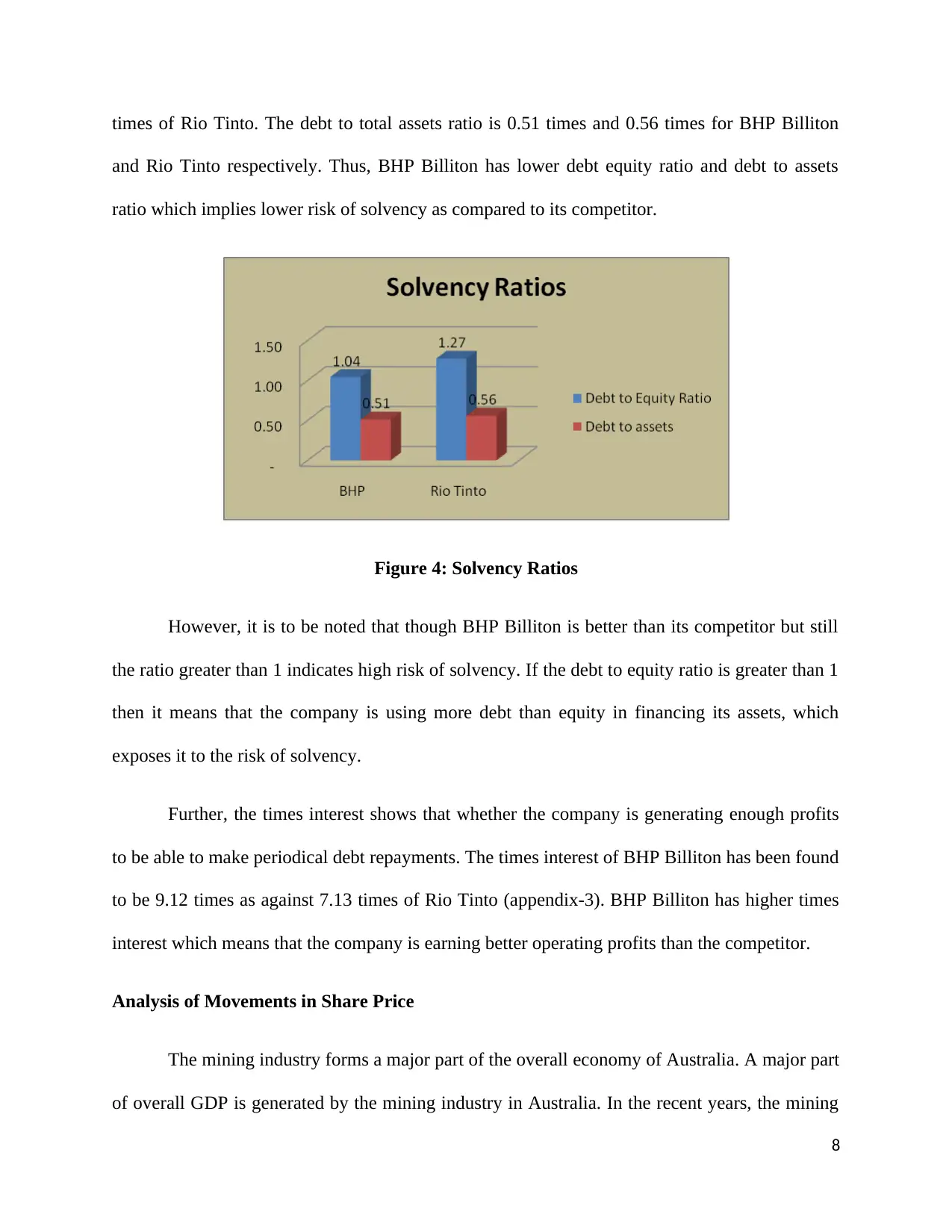
times of Rio Tinto. The debt to total assets ratio is 0.51 times and 0.56 times for BHP Billiton
and Rio Tinto respectively. Thus, BHP Billiton has lower debt equity ratio and debt to assets
ratio which implies lower risk of solvency as compared to its competitor.
Figure 4: Solvency Ratios
However, it is to be noted that though BHP Billiton is better than its competitor but still
the ratio greater than 1 indicates high risk of solvency. If the debt to equity ratio is greater than 1
then it means that the company is using more debt than equity in financing its assets, which
exposes it to the risk of solvency.
Further, the times interest shows that whether the company is generating enough profits
to be able to make periodical debt repayments. The times interest of BHP Billiton has been found
to be 9.12 times as against 7.13 times of Rio Tinto (appendix-3). BHP Billiton has higher times
interest which means that the company is earning better operating profits than the competitor.
Analysis of Movements in Share Price
The mining industry forms a major part of the overall economy of Australia. A major part
of overall GDP is generated by the mining industry in Australia. In the recent years, the mining
8
and Rio Tinto respectively. Thus, BHP Billiton has lower debt equity ratio and debt to assets
ratio which implies lower risk of solvency as compared to its competitor.
Figure 4: Solvency Ratios
However, it is to be noted that though BHP Billiton is better than its competitor but still
the ratio greater than 1 indicates high risk of solvency. If the debt to equity ratio is greater than 1
then it means that the company is using more debt than equity in financing its assets, which
exposes it to the risk of solvency.
Further, the times interest shows that whether the company is generating enough profits
to be able to make periodical debt repayments. The times interest of BHP Billiton has been found
to be 9.12 times as against 7.13 times of Rio Tinto (appendix-3). BHP Billiton has higher times
interest which means that the company is earning better operating profits than the competitor.
Analysis of Movements in Share Price
The mining industry forms a major part of the overall economy of Australia. A major part
of overall GDP is generated by the mining industry in Australia. In the recent years, the mining
8

industry has been facing decline due to low demand. The recession in the mining industry
affected the stock market so not only the individual companies but the overall market index
slopped downward.
Figure 5: Five Year Share Price
It could be observed from the graph shown above that the price of BHP Billiton’s stock
started falling down after January 2013. The stock went down from $61.69 to $56 in February
2013 and then further went down to 48 in May 2013. However, it showed recovery towards the
end of the financial year 2013 and start of 2014. It happened due to positive results declared by
the company.
Further, at the end of 2014, the company reported growth in revenues and net profits
which cause the stock to rise regain the position. In the month of June 2014, the stock traded at
$61.47 showing that it reached to the level where it dropped from. However, the stock could not
sustain the rising trend for longer. In the year 2015, China announced cut in the imports of coal
and iron ore from Australia. The demand decreased and it caused fall in prices of coal and iron
ore.
9
affected the stock market so not only the individual companies but the overall market index
slopped downward.
Figure 5: Five Year Share Price
It could be observed from the graph shown above that the price of BHP Billiton’s stock
started falling down after January 2013. The stock went down from $61.69 to $56 in February
2013 and then further went down to 48 in May 2013. However, it showed recovery towards the
end of the financial year 2013 and start of 2014. It happened due to positive results declared by
the company.
Further, at the end of 2014, the company reported growth in revenues and net profits
which cause the stock to rise regain the position. In the month of June 2014, the stock traded at
$61.47 showing that it reached to the level where it dropped from. However, the stock could not
sustain the rising trend for longer. In the year 2015, China announced cut in the imports of coal
and iron ore from Australia. The demand decreased and it caused fall in prices of coal and iron
ore.
9
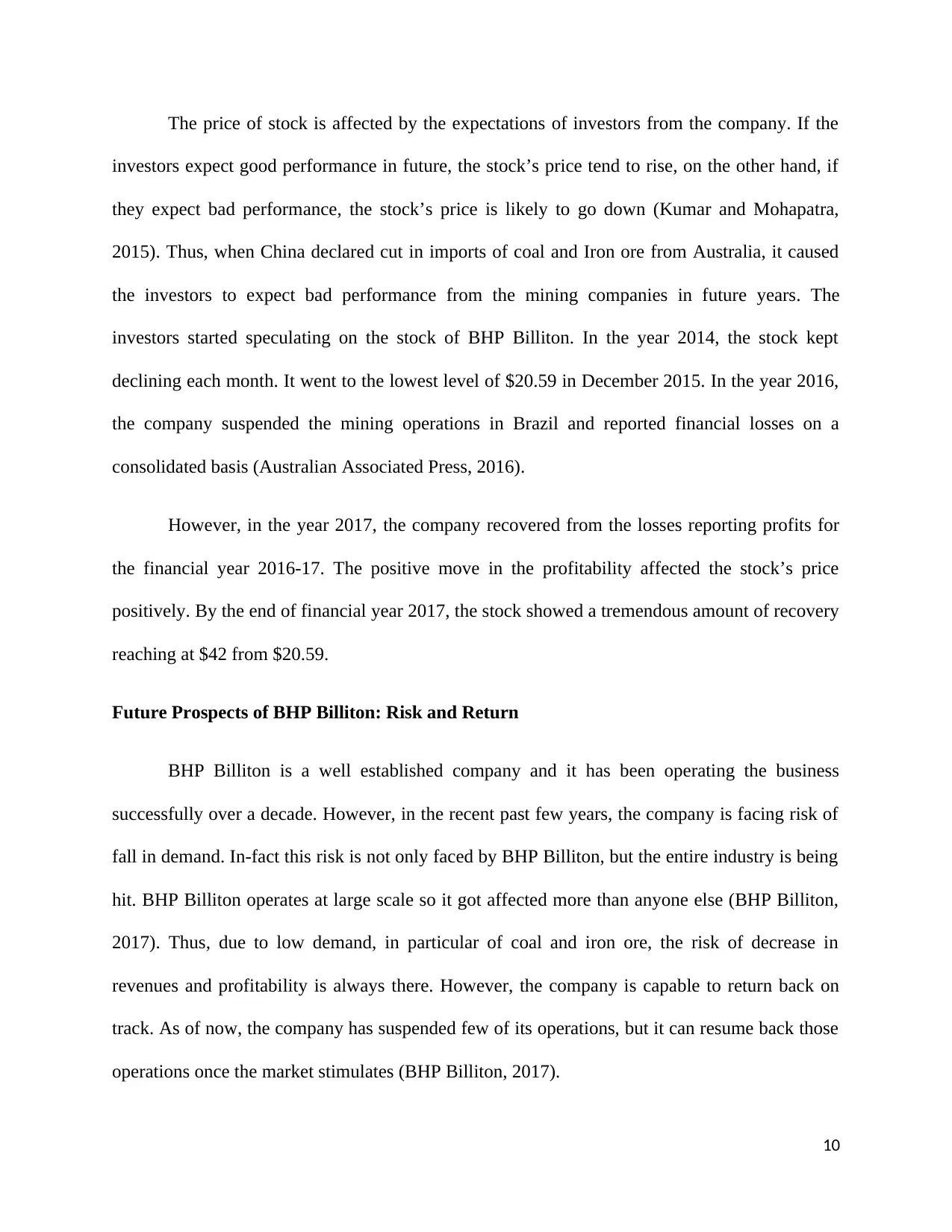
The price of stock is affected by the expectations of investors from the company. If the
investors expect good performance in future, the stock’s price tend to rise, on the other hand, if
they expect bad performance, the stock’s price is likely to go down (Kumar and Mohapatra,
2015). Thus, when China declared cut in imports of coal and Iron ore from Australia, it caused
the investors to expect bad performance from the mining companies in future years. The
investors started speculating on the stock of BHP Billiton. In the year 2014, the stock kept
declining each month. It went to the lowest level of $20.59 in December 2015. In the year 2016,
the company suspended the mining operations in Brazil and reported financial losses on a
consolidated basis (Australian Associated Press, 2016).
However, in the year 2017, the company recovered from the losses reporting profits for
the financial year 2016-17. The positive move in the profitability affected the stock’s price
positively. By the end of financial year 2017, the stock showed a tremendous amount of recovery
reaching at $42 from $20.59.
Future Prospects of BHP Billiton: Risk and Return
BHP Billiton is a well established company and it has been operating the business
successfully over a decade. However, in the recent past few years, the company is facing risk of
fall in demand. In-fact this risk is not only faced by BHP Billiton, but the entire industry is being
hit. BHP Billiton operates at large scale so it got affected more than anyone else (BHP Billiton,
2017). Thus, due to low demand, in particular of coal and iron ore, the risk of decrease in
revenues and profitability is always there. However, the company is capable to return back on
track. As of now, the company has suspended few of its operations, but it can resume back those
operations once the market stimulates (BHP Billiton, 2017).
10
investors expect good performance in future, the stock’s price tend to rise, on the other hand, if
they expect bad performance, the stock’s price is likely to go down (Kumar and Mohapatra,
2015). Thus, when China declared cut in imports of coal and Iron ore from Australia, it caused
the investors to expect bad performance from the mining companies in future years. The
investors started speculating on the stock of BHP Billiton. In the year 2014, the stock kept
declining each month. It went to the lowest level of $20.59 in December 2015. In the year 2016,
the company suspended the mining operations in Brazil and reported financial losses on a
consolidated basis (Australian Associated Press, 2016).
However, in the year 2017, the company recovered from the losses reporting profits for
the financial year 2016-17. The positive move in the profitability affected the stock’s price
positively. By the end of financial year 2017, the stock showed a tremendous amount of recovery
reaching at $42 from $20.59.
Future Prospects of BHP Billiton: Risk and Return
BHP Billiton is a well established company and it has been operating the business
successfully over a decade. However, in the recent past few years, the company is facing risk of
fall in demand. In-fact this risk is not only faced by BHP Billiton, but the entire industry is being
hit. BHP Billiton operates at large scale so it got affected more than anyone else (BHP Billiton,
2017). Thus, due to low demand, in particular of coal and iron ore, the risk of decrease in
revenues and profitability is always there. However, the company is capable to return back on
track. As of now, the company has suspended few of its operations, but it can resume back those
operations once the market stimulates (BHP Billiton, 2017).
10
Secure Best Marks with AI Grader
Need help grading? Try our AI Grader for instant feedback on your assignments.
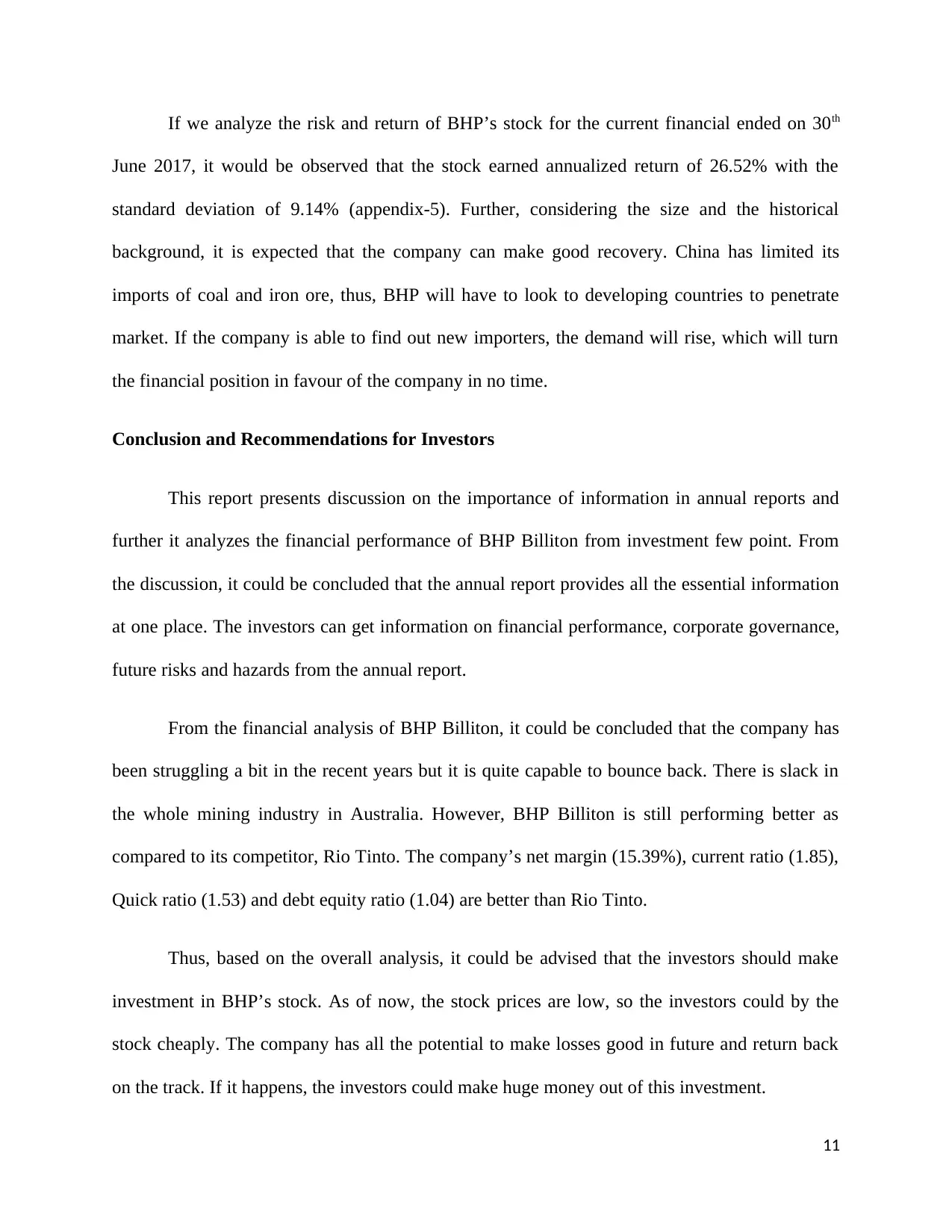
If we analyze the risk and return of BHP’s stock for the current financial ended on 30th
June 2017, it would be observed that the stock earned annualized return of 26.52% with the
standard deviation of 9.14% (appendix-5). Further, considering the size and the historical
background, it is expected that the company can make good recovery. China has limited its
imports of coal and iron ore, thus, BHP will have to look to developing countries to penetrate
market. If the company is able to find out new importers, the demand will rise, which will turn
the financial position in favour of the company in no time.
Conclusion and Recommendations for Investors
This report presents discussion on the importance of information in annual reports and
further it analyzes the financial performance of BHP Billiton from investment few point. From
the discussion, it could be concluded that the annual report provides all the essential information
at one place. The investors can get information on financial performance, corporate governance,
future risks and hazards from the annual report.
From the financial analysis of BHP Billiton, it could be concluded that the company has
been struggling a bit in the recent years but it is quite capable to bounce back. There is slack in
the whole mining industry in Australia. However, BHP Billiton is still performing better as
compared to its competitor, Rio Tinto. The company’s net margin (15.39%), current ratio (1.85),
Quick ratio (1.53) and debt equity ratio (1.04) are better than Rio Tinto.
Thus, based on the overall analysis, it could be advised that the investors should make
investment in BHP’s stock. As of now, the stock prices are low, so the investors could by the
stock cheaply. The company has all the potential to make losses good in future and return back
on the track. If it happens, the investors could make huge money out of this investment.
11
June 2017, it would be observed that the stock earned annualized return of 26.52% with the
standard deviation of 9.14% (appendix-5). Further, considering the size and the historical
background, it is expected that the company can make good recovery. China has limited its
imports of coal and iron ore, thus, BHP will have to look to developing countries to penetrate
market. If the company is able to find out new importers, the demand will rise, which will turn
the financial position in favour of the company in no time.
Conclusion and Recommendations for Investors
This report presents discussion on the importance of information in annual reports and
further it analyzes the financial performance of BHP Billiton from investment few point. From
the discussion, it could be concluded that the annual report provides all the essential information
at one place. The investors can get information on financial performance, corporate governance,
future risks and hazards from the annual report.
From the financial analysis of BHP Billiton, it could be concluded that the company has
been struggling a bit in the recent years but it is quite capable to bounce back. There is slack in
the whole mining industry in Australia. However, BHP Billiton is still performing better as
compared to its competitor, Rio Tinto. The company’s net margin (15.39%), current ratio (1.85),
Quick ratio (1.53) and debt equity ratio (1.04) are better than Rio Tinto.
Thus, based on the overall analysis, it could be advised that the investors should make
investment in BHP’s stock. As of now, the stock prices are low, so the investors could by the
stock cheaply. The company has all the potential to make losses good in future and return back
on the track. If it happens, the investors could make huge money out of this investment.
11
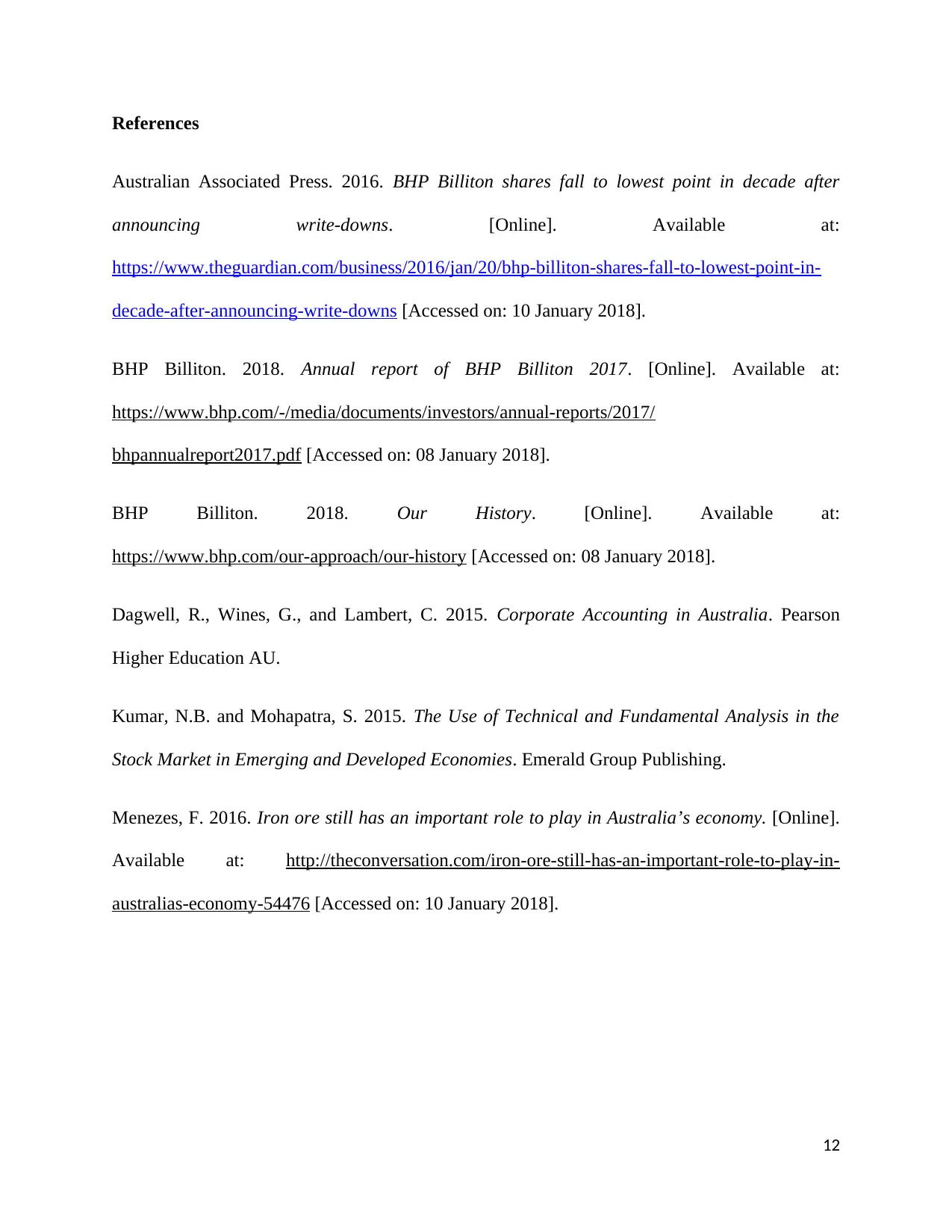
References
Australian Associated Press. 2016. BHP Billiton shares fall to lowest point in decade after
announcing write-downs. [Online]. Available at:
https://www.theguardian.com/business/2016/jan/20/bhp-billiton-shares-fall-to-lowest-point-in-
decade-after-announcing-write-downs [Accessed on: 10 January 2018].
BHP Billiton. 2018. Annual report of BHP Billiton 2017. [Online]. Available at:
https://www.bhp.com/-/media/documents/investors/annual-reports/2017/
bhpannualreport2017.pdf [Accessed on: 08 January 2018].
BHP Billiton. 2018. Our History. [Online]. Available at:
https://www.bhp.com/our-approach/our-history [Accessed on: 08 January 2018].
Dagwell, R., Wines, G., and Lambert, C. 2015. Corporate Accounting in Australia. Pearson
Higher Education AU.
Kumar, N.B. and Mohapatra, S. 2015. The Use of Technical and Fundamental Analysis in the
Stock Market in Emerging and Developed Economies. Emerald Group Publishing.
Menezes, F. 2016. Iron ore still has an important role to play in Australia’s economy. [Online].
Available at: http://theconversation.com/iron-ore-still-has-an-important-role-to-play-in-
australias-economy-54476 [Accessed on: 10 January 2018].
12
Australian Associated Press. 2016. BHP Billiton shares fall to lowest point in decade after
announcing write-downs. [Online]. Available at:
https://www.theguardian.com/business/2016/jan/20/bhp-billiton-shares-fall-to-lowest-point-in-
decade-after-announcing-write-downs [Accessed on: 10 January 2018].
BHP Billiton. 2018. Annual report of BHP Billiton 2017. [Online]. Available at:
https://www.bhp.com/-/media/documents/investors/annual-reports/2017/
bhpannualreport2017.pdf [Accessed on: 08 January 2018].
BHP Billiton. 2018. Our History. [Online]. Available at:
https://www.bhp.com/our-approach/our-history [Accessed on: 08 January 2018].
Dagwell, R., Wines, G., and Lambert, C. 2015. Corporate Accounting in Australia. Pearson
Higher Education AU.
Kumar, N.B. and Mohapatra, S. 2015. The Use of Technical and Fundamental Analysis in the
Stock Market in Emerging and Developed Economies. Emerald Group Publishing.
Menezes, F. 2016. Iron ore still has an important role to play in Australia’s economy. [Online].
Available at: http://theconversation.com/iron-ore-still-has-an-important-role-to-play-in-
australias-economy-54476 [Accessed on: 10 January 2018].
12
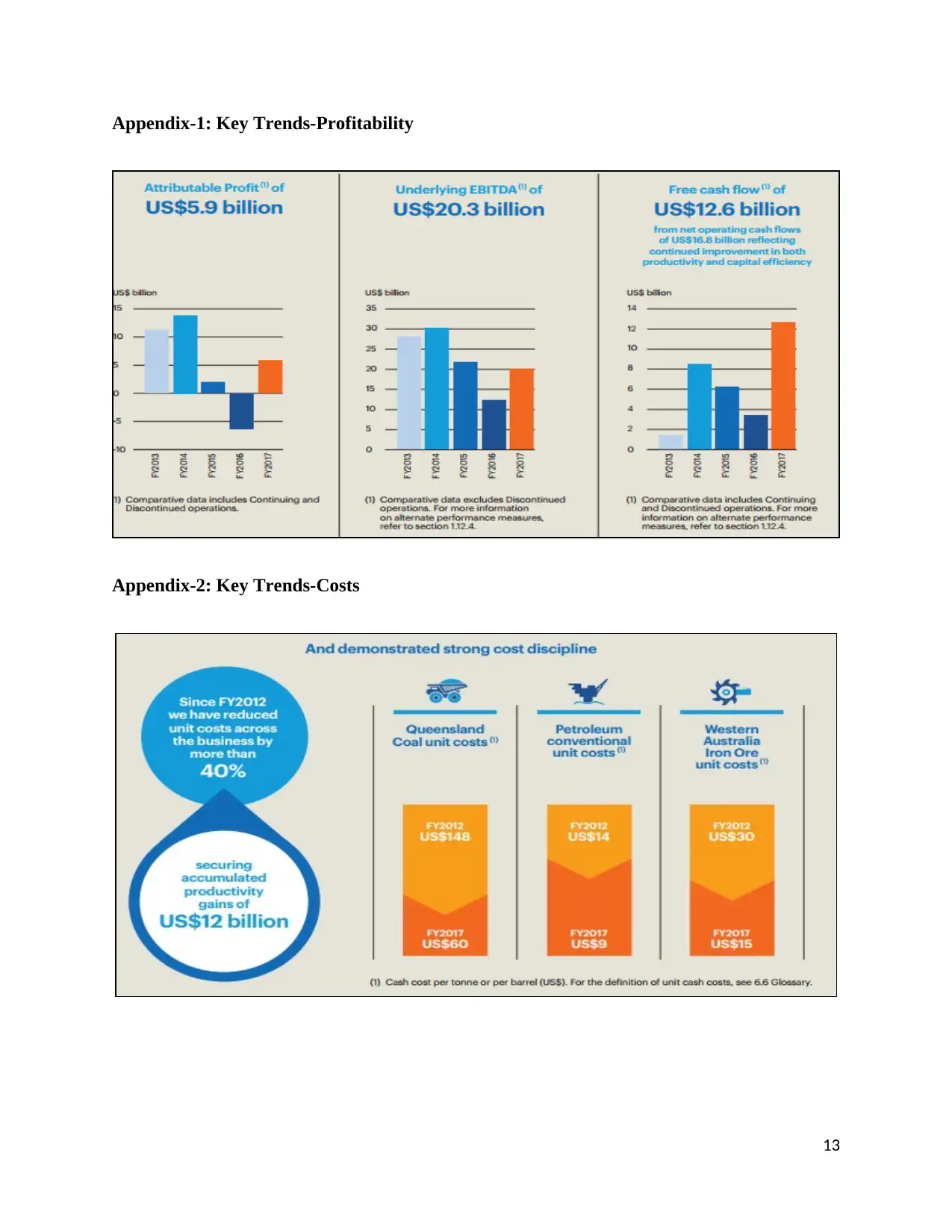
Appendix-1: Key Trends-Profitability
Appendix-2: Key Trends-Costs
13
Appendix-2: Key Trends-Costs
13
Paraphrase This Document
Need a fresh take? Get an instant paraphrase of this document with our AI Paraphraser
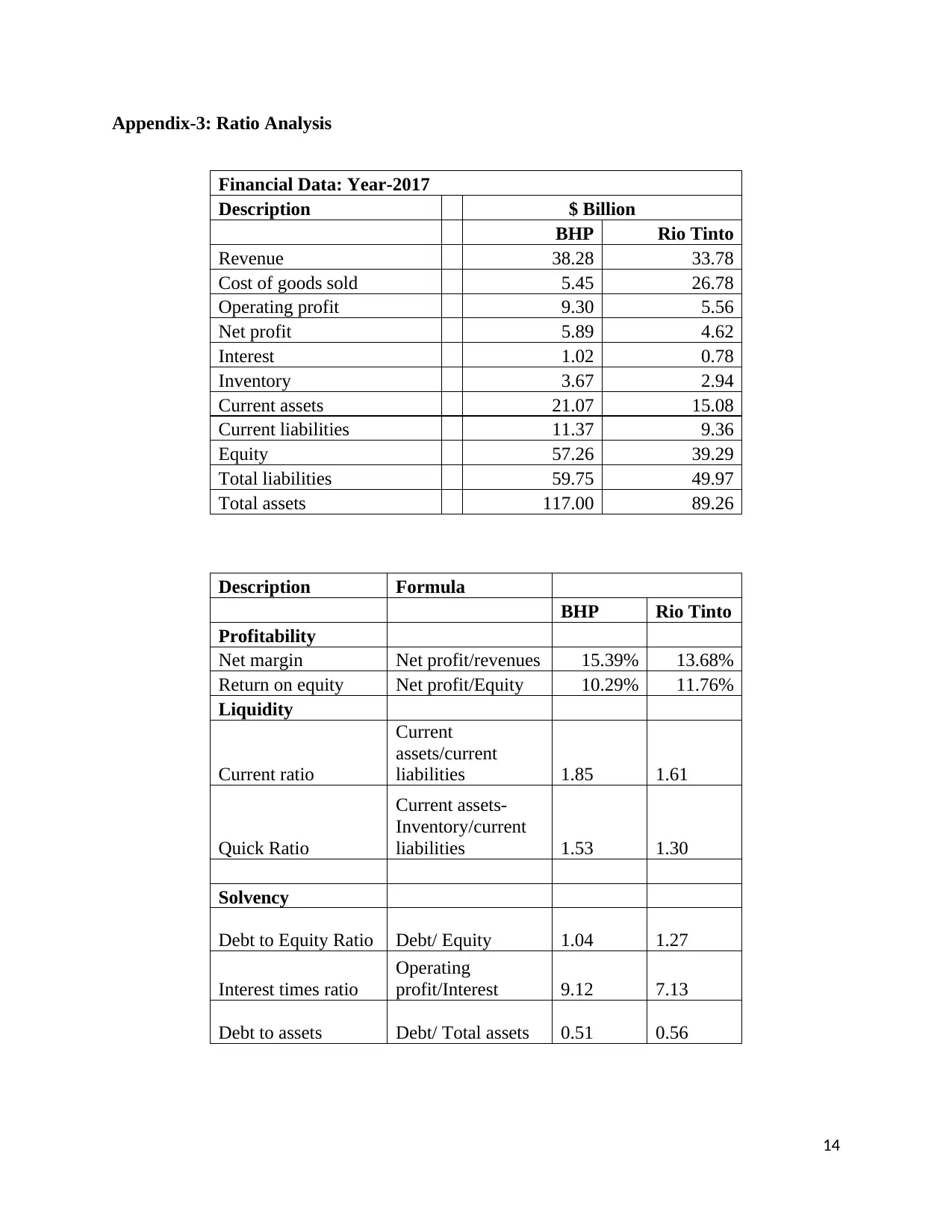
Appendix-3: Ratio Analysis
Financial Data: Year-2017
Description $ Billion
BHP Rio Tinto
Revenue 38.28 33.78
Cost of goods sold 5.45 26.78
Operating profit 9.30 5.56
Net profit 5.89 4.62
Interest 1.02 0.78
Inventory 3.67 2.94
Current assets 21.07 15.08
Current liabilities 11.37 9.36
Equity 57.26 39.29
Total liabilities 59.75 49.97
Total assets 117.00 89.26
Description Formula
BHP Rio Tinto
Profitability
Net margin Net profit/revenues 15.39% 13.68%
Return on equity Net profit/Equity 10.29% 11.76%
Liquidity
Current ratio
Current
assets/current
liabilities 1.85 1.61
Quick Ratio
Current assets-
Inventory/current
liabilities 1.53 1.30
Solvency
Debt to Equity Ratio Debt/ Equity 1.04 1.27
Interest times ratio
Operating
profit/Interest 9.12 7.13
Debt to assets Debt/ Total assets 0.51 0.56
14
Financial Data: Year-2017
Description $ Billion
BHP Rio Tinto
Revenue 38.28 33.78
Cost of goods sold 5.45 26.78
Operating profit 9.30 5.56
Net profit 5.89 4.62
Interest 1.02 0.78
Inventory 3.67 2.94
Current assets 21.07 15.08
Current liabilities 11.37 9.36
Equity 57.26 39.29
Total liabilities 59.75 49.97
Total assets 117.00 89.26
Description Formula
BHP Rio Tinto
Profitability
Net margin Net profit/revenues 15.39% 13.68%
Return on equity Net profit/Equity 10.29% 11.76%
Liquidity
Current ratio
Current
assets/current
liabilities 1.85 1.61
Quick Ratio
Current assets-
Inventory/current
liabilities 1.53 1.30
Solvency
Debt to Equity Ratio Debt/ Equity 1.04 1.27
Interest times ratio
Operating
profit/Interest 9.12 7.13
Debt to assets Debt/ Total assets 0.51 0.56
14
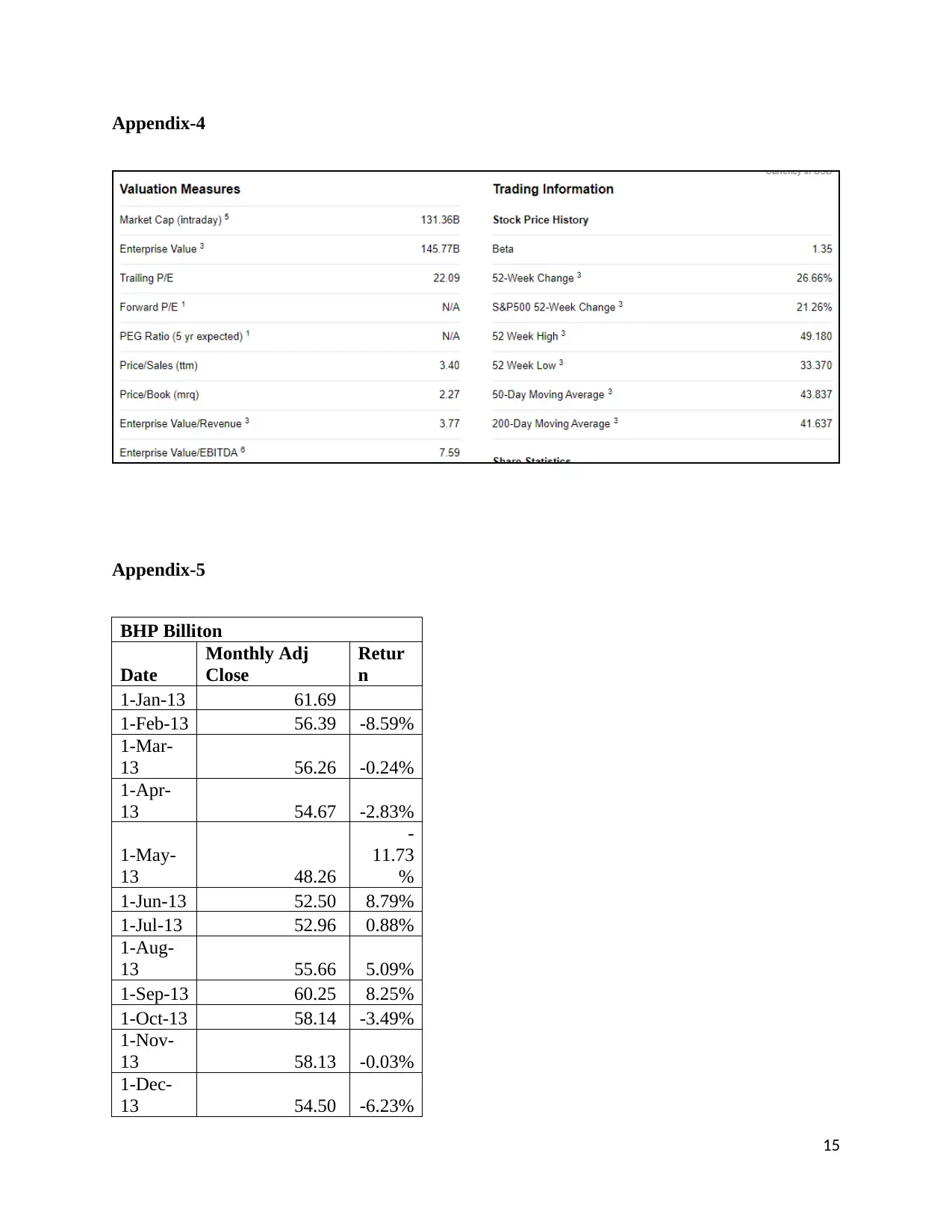
Appendix-4
Appendix-5
BHP Billiton
Date
Monthly Adj
Close
Retur
n
1-Jan-13 61.69
1-Feb-13 56.39 -8.59%
1-Mar-
13 56.26 -0.24%
1-Apr-
13 54.67 -2.83%
1-May-
13 48.26
-
11.73
%
1-Jun-13 52.50 8.79%
1-Jul-13 52.96 0.88%
1-Aug-
13 55.66 5.09%
1-Sep-13 60.25 8.25%
1-Oct-13 58.14 -3.49%
1-Nov-
13 58.13 -0.03%
1-Dec-
13 54.50 -6.23%
15
Appendix-5
BHP Billiton
Date
Monthly Adj
Close
Retur
n
1-Jan-13 61.69
1-Feb-13 56.39 -8.59%
1-Mar-
13 56.26 -0.24%
1-Apr-
13 54.67 -2.83%
1-May-
13 48.26
-
11.73
%
1-Jun-13 52.50 8.79%
1-Jul-13 52.96 0.88%
1-Aug-
13 55.66 5.09%
1-Sep-13 60.25 8.25%
1-Oct-13 58.14 -3.49%
1-Nov-
13 58.13 -0.03%
1-Dec-
13 54.50 -6.23%
15
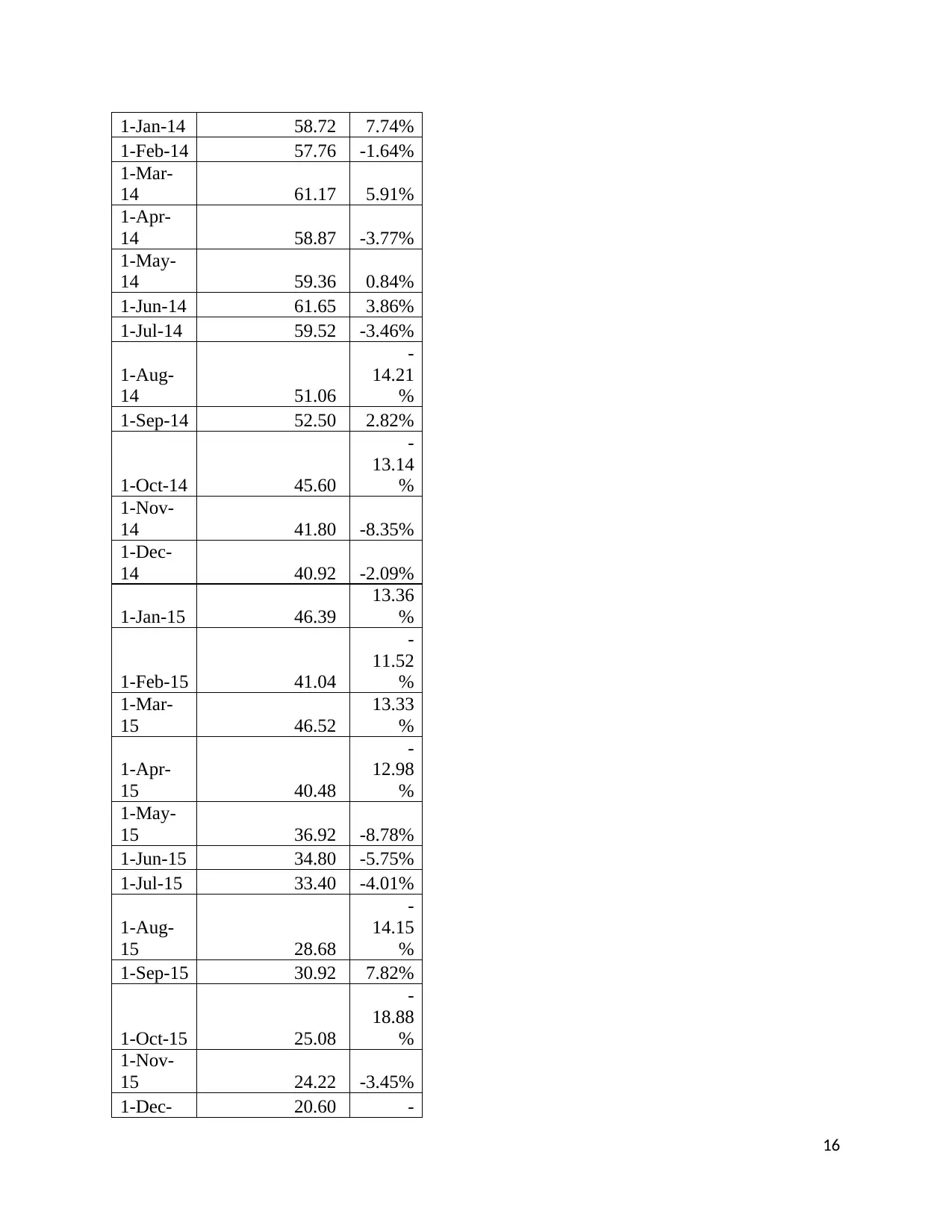
1-Jan-14 58.72 7.74%
1-Feb-14 57.76 -1.64%
1-Mar-
14 61.17 5.91%
1-Apr-
14 58.87 -3.77%
1-May-
14 59.36 0.84%
1-Jun-14 61.65 3.86%
1-Jul-14 59.52 -3.46%
1-Aug-
14 51.06
-
14.21
%
1-Sep-14 52.50 2.82%
1-Oct-14 45.60
-
13.14
%
1-Nov-
14 41.80 -8.35%
1-Dec-
14 40.92 -2.09%
1-Jan-15 46.39
13.36
%
1-Feb-15 41.04
-
11.52
%
1-Mar-
15 46.52
13.33
%
1-Apr-
15 40.48
-
12.98
%
1-May-
15 36.92 -8.78%
1-Jun-15 34.80 -5.75%
1-Jul-15 33.40 -4.01%
1-Aug-
15 28.68
-
14.15
%
1-Sep-15 30.92 7.82%
1-Oct-15 25.08
-
18.88
%
1-Nov-
15 24.22 -3.45%
1-Dec- 20.60 -
16
1-Feb-14 57.76 -1.64%
1-Mar-
14 61.17 5.91%
1-Apr-
14 58.87 -3.77%
1-May-
14 59.36 0.84%
1-Jun-14 61.65 3.86%
1-Jul-14 59.52 -3.46%
1-Aug-
14 51.06
-
14.21
%
1-Sep-14 52.50 2.82%
1-Oct-14 45.60
-
13.14
%
1-Nov-
14 41.80 -8.35%
1-Dec-
14 40.92 -2.09%
1-Jan-15 46.39
13.36
%
1-Feb-15 41.04
-
11.52
%
1-Mar-
15 46.52
13.33
%
1-Apr-
15 40.48
-
12.98
%
1-May-
15 36.92 -8.78%
1-Jun-15 34.80 -5.75%
1-Jul-15 33.40 -4.01%
1-Aug-
15 28.68
-
14.15
%
1-Sep-15 30.92 7.82%
1-Oct-15 25.08
-
18.88
%
1-Nov-
15 24.22 -3.45%
1-Dec- 20.60 -
16
Secure Best Marks with AI Grader
Need help grading? Try our AI Grader for instant feedback on your assignments.
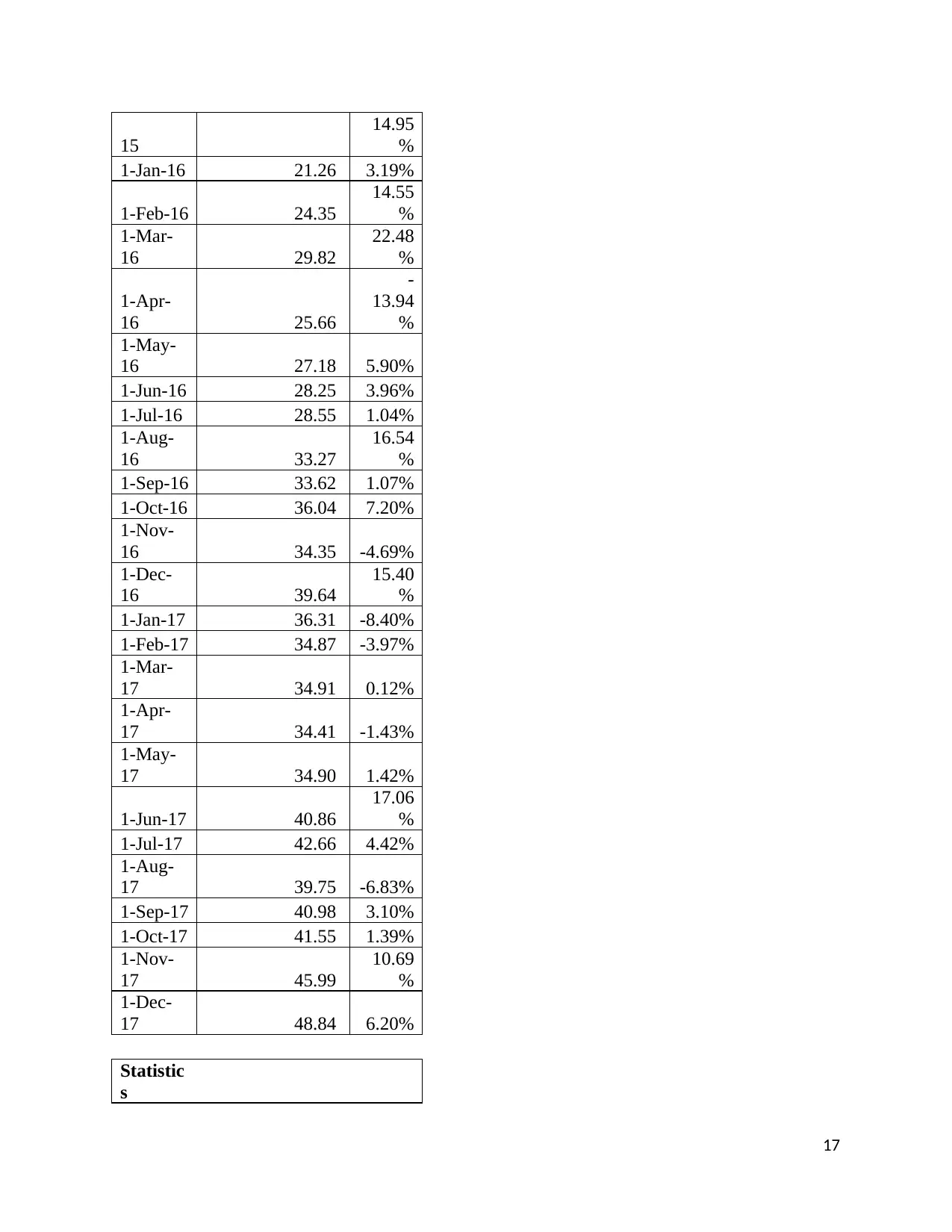
15
14.95
%
1-Jan-16 21.26 3.19%
1-Feb-16 24.35
14.55
%
1-Mar-
16 29.82
22.48
%
1-Apr-
16 25.66
-
13.94
%
1-May-
16 27.18 5.90%
1-Jun-16 28.25 3.96%
1-Jul-16 28.55 1.04%
1-Aug-
16 33.27
16.54
%
1-Sep-16 33.62 1.07%
1-Oct-16 36.04 7.20%
1-Nov-
16 34.35 -4.69%
1-Dec-
16 39.64
15.40
%
1-Jan-17 36.31 -8.40%
1-Feb-17 34.87 -3.97%
1-Mar-
17 34.91 0.12%
1-Apr-
17 34.41 -1.43%
1-May-
17 34.90 1.42%
1-Jun-17 40.86
17.06
%
1-Jul-17 42.66 4.42%
1-Aug-
17 39.75 -6.83%
1-Sep-17 40.98 3.10%
1-Oct-17 41.55 1.39%
1-Nov-
17 45.99
10.69
%
1-Dec-
17 48.84 6.20%
Statistic
s
17
14.95
%
1-Jan-16 21.26 3.19%
1-Feb-16 24.35
14.55
%
1-Mar-
16 29.82
22.48
%
1-Apr-
16 25.66
-
13.94
%
1-May-
16 27.18 5.90%
1-Jun-16 28.25 3.96%
1-Jul-16 28.55 1.04%
1-Aug-
16 33.27
16.54
%
1-Sep-16 33.62 1.07%
1-Oct-16 36.04 7.20%
1-Nov-
16 34.35 -4.69%
1-Dec-
16 39.64
15.40
%
1-Jan-17 36.31 -8.40%
1-Feb-17 34.87 -3.97%
1-Mar-
17 34.91 0.12%
1-Apr-
17 34.41 -1.43%
1-May-
17 34.90 1.42%
1-Jun-17 40.86
17.06
%
1-Jul-17 42.66 4.42%
1-Aug-
17 39.75 -6.83%
1-Sep-17 40.98 3.10%
1-Oct-17 41.55 1.39%
1-Nov-
17 45.99
10.69
%
1-Dec-
17 48.84 6.20%
Statistic
s
17

Monthly average 2017 1.98%
Annualized return of 2017
26.52
%
Standard deviation 9.14%
Minimum price over five
year 20.60
Maximum price over five
year 61.69
18
Annualized return of 2017
26.52
%
Standard deviation 9.14%
Minimum price over five
year 20.60
Maximum price over five
year 61.69
18
1 out of 18
Related Documents
Your All-in-One AI-Powered Toolkit for Academic Success.
+13062052269
info@desklib.com
Available 24*7 on WhatsApp / Email
![[object Object]](/_next/static/media/star-bottom.7253800d.svg)
Unlock your academic potential
© 2024 | Zucol Services PVT LTD | All rights reserved.





